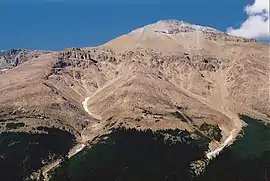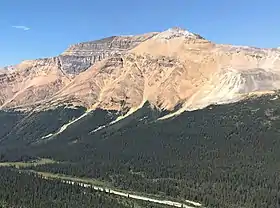Observation Peak (Alberta)
Observation Peak is a 3,174-metre (10,413-foot) mountain summit located in Banff National Park, Alberta, Canada. The mountain can be seen from the Icefields Parkway near the Bow Summit.
| Observation Peak | |
|---|---|
 Observation Peak, July 2003. Visible high point is the false summit. | |
| Highest point | |
| Elevation | 3,174 m (10,413 ft) [1][2] |
| Prominence | 644 m (2,113 ft) [3] |
| Listing | Mountains of Alberta |
| Coordinates | 51°44′32″N 116°28′01″W [4] |
| Geography | |
 Observation Peak | |
| Parent range | Canadian Rockies |
| Topo map | NTS 82N/09 Hector Lake |
| Geology | |
| Age of rock | Precambrian to Jurassic |
| Mountain type | sedimentary rock |
| Climbing | |
| First ascent | 1895 by Bill Peyto and Walter Wilcox[3] |
| Easiest route | easy/moderate scramble[5] |

The peak was named in 1898 by Charles L. Noyes, a Boston clergyman, who upon climbing to the top found it to have the best viewpoint he had ever reached.[3][1]
The mountain can be scrambled using the western slopes and after reaching the top of the false summit, a 20-minute plod to the northwest leads to the true summit about 100 metres (328 ft) higher.[5]
Geology
Like other mountains in Banff Park, the mountain is composed of sedimentary rock laid down during the Precambrian to Jurassic periods.[6] Formed in shallow seas, this sedimentary rock was pushed east and over the top of younger rock during the Laramide orogeny.[7]
Climate
Based on the Köppen climate classification, Observation Peak is located in a subarctic climate with cold, snowy winters, and mild summers.[8] Temperatures can drop below -20 °C with wind chill factors below -30 °C. Precipitation runoff from Observation Peak drains into the Mistaya River, a tributary of the North Saskatchewan River.
References
- "Observation Peak". PeakFinder.com. Retrieved 2012-06-29.
- Bow Lake and Saskatchewan Crossing (Map) (2nd ed.). 1:70,000. Cochrane, AB: Gem Trek Publishing. 2000. ISBN 1-895526-10-8. Retrieved 2019-06-13.
- "Observation Peak". Bivouac.com. Retrieved 2012-06-29.
- "Observation Peak". Geographical Names Data Base. Natural Resources Canada. Retrieved 2019-06-13.
- Kane, Alan (1999). "Observation Peak". Scrambles in the Canadian Rockies. Calgary: Rocky Mountain Books. p. 298. ISBN 0-921102-67-4.
- Belyea, Helen R. (1960). The Story of the Mountains in Banff National Park (PDF). parkscanadahistory.com (Report). Ottawa: Geological Survey of Canada. Archived (PDF) from the original on 2015-10-02. Retrieved 2019-09-13.
- Gadd, Ben (2008). Geology of the Rocky Mountains and Columbias.
- Peel, M. C.; Finlayson, B. L.; McMahon, T. A. (2007). "Updated world map of the Köppen−Geiger climate classification". Hydrol. Earth Syst. Sci. 11: 1633–1644. ISSN 1027-5606.
External links
- Parks Canada web site: Banff National Park